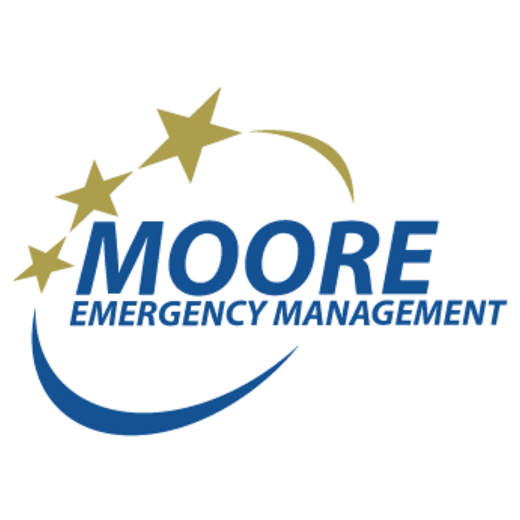Storm Sheltering
When Tornado or Severe Thunderstorm Warnings are issued, time is of the essence. Both tornadoes and severe thunderstorms can easily produce winds of over 100 mph. Winds of this speed will pick up all manner of debris, turning normally docile items into high-speed missiles. The high-speed missiles are then capable of penetrating and injuring the body; overturning both light and heavy vehicles; debranch and/or topple trees; and damage and/or blow down walls and buildings. Quickly taking shelter from these winds has proven time and again to save lives. Normally sheltering can be right where you are.
Sheltering In-Place
Unless you are in a mobile home or a portable building, normally the best place to take shelter is “in-place”, right where you are. The best place to take shelter is in a basement or a below-ground location. The winds blow only from ground-level up; therefore being below ground eliminates the missiles which cause harm, and doesn’t allow the winds to cause direct building damage below ground level. Typically the main threat when below ground level comes in damaged buildings falling through the ground level floor and onto those below. Unfortunately, few homes in Moore have basements, and only about 10% or less have below-ground storm shelters. This in mind, shelter can also normally be taken above ground. Again, the object is to try to stop the wind-driven missiles, and minimize your exposure to walls that are exposed to the strongest winds. To take shelter above ground, choose a location with as many walls between you and the outside world as possible. This helps to minimize the possibility of being next to a wall failing from direct winds, and also allows the walls to slow or stop the missiles. Choose a small room, which tends to be stronger. Try to get under something sturdy, like a desk, and cover yourself with heavy blankets or coats. Again, you’re trying to protect yourself from flying debris, failing walls, and falling items. A caution: When evaluating potential shelter locations, be sure to look UP as well. If you’re sheltering in a closet, you certainly won’t want to have large, heavy items on the shelves above you. Information on improving your home to better withstand storm winds, as well as building a storm “safe room” can be found on-line from both the Federal Emergency Management Agency and the Texas Tech University Wind Engineering Research Center.
“Community” Shelters
The City of Moore has no community (or “public”) tornado shelters. This is due to two factors: Overall, people face less risk by taking shelter in a reasonably-well constructed residence! There is no public building in Moore which has a suitable location for a shelter. Yes, there is less overall risk by sheltering-in-place than by going to a community shelter. The average tornado warning time is generally only 10-15 minutes. That’s just not enough time for a person to receive the warning, make a conscious decision to leave their home, gather the few things needed (family, keys, etc.), lock the house, get into the car, drive to a shelter (including possibly experiencing a traffic jam of others trying to get to the same shelter!), get out of the car, and make the way into the community shelter. In this scenario, there’s a far greater likelihood of getting caught in your car when the tornado strikes! And experience proves that cars are NOT the place you want to be during severe weather events! On May 3, 1999, one of the most violent tornadoes ever recorded struck central Oklahoma, including the northwest part of Moore in its path. Warning for this event was outstanding – one research survey suggests that over 95% of the people in central Oklahoma knew of the tornado and its location. While many people evacuated, many others took shelter in their homes. The vast majority of these people…in fact all but three in Moore…survived! Their homes were destroyed, but the people survived. Emergency management and weather warning professionals see this as a testament to the tornado safety rules have been advocated for years: “In homes or small buildings, go to the basement (if available) or to an interior room on the lowest floor, such as a closet or bathroom. Wrap yourself in overcoats or blankets to protect yourself from flying debris.” May 3rd was an extremely unique event weather wise. There has never been such a strong and violent tornado ever in the recorded history of the City of Moore. Statistically, there is only about a 1-2% chance of a tornado – of any size – striking Moore on any particular day during the spring. But of all tornadoes that do strike us (again, not very many historically), there’s only a less than 1% chance of it being as strong and violent as what we experienced on May 3rd. Put another way, there’s a very small likelihood of Moore being struck by a tornado. There’s an extremely smaller chance of Moore experiencing another “May 3rd” type event. If we are struck again, it will very likely be by a much less intense storm. Sheltering in your residence – assuming it is a reasonably-well constructed home – is the best option. The opinion of our emergency management severe weather professionals is that community sheltering is not only not possible in our situation, but not advisable.
Schools
All of the schools in the Moore Public School district have plans – coordinated with the Emergency Management office of the City – for monitoring severe weather conditions and for placing students and staff into shelter during severe weather events. As of 2019, all Moore Public School sites have engineered safe rooms for their students and staff. Note that these shelters are not open to the general public.
Businesses
It is highly advantageous for all business to have disaster plans for their facilities. It is also incumbent on each and every individual person to know where to take shelter in places frequented. The same rules apply as at home…as far down and as far inside as you can get, staying away from long-span roofs and windows. Business owners and managers can contact the Emergency Management Department for assistance in developing their disaster plans.
Non-Desirable Locations
If you don’t live in a “reasonably-well constructed residence” – such as a mobile home – then we certainly would hope that you plan to leave your home and find shelter in a better location. This requires advance planning on your part! It also requires keeping a much sharper eye to deteriorating weather conditions! Have a family emergency plan, and don’t hesitate in activating it. If your plan is to leave your home for better shelter, DO NOT WAIT UNTIL TORNADO WARNINGS ARE ISSUED to leave for shelter!
Conclusion
We at the City of Moore Emergency Management Department advocate that every residence have a storm safe-room or an underground cellar. We also advocate the purchase of NOAA Weather Radios, which we’ll help program if you need. We have an active cadre of trained weather spotters, real-time weather data and radar in our Emergency Operations Center, and a state-of-the-art, multiple-path warning system. In short, we do everything possible to assist our residents in ensuring their safety during severe weather events.
Highway Bridges
Much of the following material is taken from “Highway Overpasses as Tornado Shelters”, by Daniel J. Miller, National Weather Service Forecast Office-Norman, and Charles A. Doswell III, Harold E. Brooks, Gregory J. Stumpf, and Erik Rasmussen of the National Severe Storms Laboratory.
Over the past 20 years, public perception that highway overpasses offer sound shelter from tornado winds has increased substantially, particularly as result of a widely distributed video from April 26, 1991 on the Kansas Turnpike. However, it appears that highway overpasses offer, at best, questionable shelter not only from tornadoes, but severe storms in general: three people in Oklahoma lost their lives while seeking shelter near or under overpass bridges, including one here in Moore at the Shields Blvd. bridge over I-35. It is our contention that highway overpasses are inadequate tornado sheltering locations for the following meteorological reasons.
- ALL tornadoes have some amount of debris within their near-surface flow. In the case of a strong or violent tornado, much more debris would be present, traveling at much higher speeds, especially when debris from man-made structures is involved. In strong and violent tornadoes, typically harmless everyday items such as shingles, boards, pop cans, dishes (or pieces thereof) become dangerous missiles and are responsible for most tornado casualties.
- By climbing up under an overpass, people will be exposed to higher wind speeds and more flying debris.
- The narrow passage underneath an overpass might cause an increase in the wind speed under the bridge. The extent to which this is true, and the circumstances under which it could happen are not known, but this is at least a possibility.
- Most overpasses don’t have girders or support beams for handholds or small ledges into which to crawl.
- Finally, if an overpass is directly in the path of a tornado, the wind will change direction nearly 180 degrees as the vortex passes. Thus, if one side of the overpass was protected from the highest wind speeds as the tornado approached, that same side of the bridge will be completely exposed to the wind and flying debris as the tornado moves away and vice-versa.
Taking shelter under a highway overpass is to become a stationary target for flying debris, with a substantial risk of being blown out and carried by the tornado winds. Safety in such a location is merely an illusion. Click on the graphic to see an animated explanation of this, courtesy of USA Today (graphic ©copyright 1999 USA Today, a division of Gannett Co. Inc.) Other extremely important reasons why seeking shelter from tornadoes and severe storms underneath overpasses are the non-weather issues. When a traffic jam results from blocked free flow of traffic because a multitude of vehicles parked near an overpass, this forces many others into the same desperate situation, unnecessarily. This happened at Shields Boulevard on May 3, and has also happened in several other severe storm situations. Once people start to seek shelter under overpasses, a potentially lethal series of consequences begins:- The free flow of traffic is blocked.
- Other potential escape routes are blocked by this stalled traffic, especially on limited-access roads such as interstate highways.
- There is also the potential for a major traffic accident in the form of a chain reaction during low visibility and/or nighttime events, where oncoming traffic might not be able to see the stopped vehicles in time to prevent collisions, adding to the blockage.
- A tornado hitting such an involuntary assemblage of vehicles will leave a deposit of rubble and vehicles, rendering the road impassible for several hours.
- The blocked road would prevent emergency vehicles from gaining access to the affected area.
- We experienced every one of these consequences in Moore on May 3rd!
Despite all of the incredibly valid meteorological reasons why overpasses are very bad places to be, the traffic blockage aspect may be just as important of a reason why we need to minimize this practice! We must avoid forcing others into the same desperate situation by blocking the road!
Finally, there were also a few people on May 3 who ACTUALLY LEFT THEIR HOMES TO DRIVE TO THE NEAREST HIGHWAY OVERPASS TO SEEK SHELTER! As has been stated before, the current guidelines for people in buildings are extremely effective when practiced properly, and in almost no instance should one leave a soundly constructed building that has an interior room in a tornado situation!

